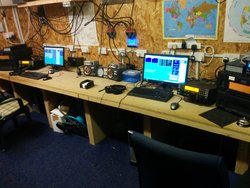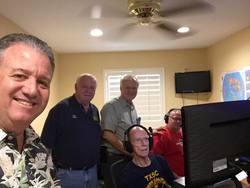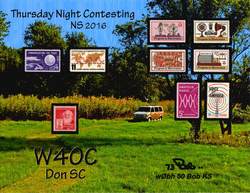 November 2, 2016 Editor: Paul Bourque, N1SFE | ||||
IN THIS ISSUE
The ARRL Sweepstakes, CW is coming up this weekend, and that's where you'll find a lot of domestic activity. If you have not tried Sweepstakes before, you'll find that the exchange is a bit more challenging than many contests. The longer Sweepstakes exchange is rooted in the National Traffic System Message Format. The WAE DX (Worked All Europe) contests (CW, RTTY, Phone) also have a "message handling" component, in the form of QTCs. In the popular RTTY version of the contest on November 12, everyone can work everyone, and QTC traffic can be sent and received between continents. You'll likely find that your logging program can already send and receive QTCs for you, you'll just need to know how to use the feature. Also on the weekend of November 12 is the JIDX Phone contest, which is consistently popular with amateurs on the west coast of the US. W1AW bulletins containing DX or propagation information can be received over the air, or via e-mail. You can manage subscriptions to ARRL e-mail bulletins at http://arrl.org/bulletins. The schedule for daily digital transmission of W1AW bulletins is also available online. BUSTED QSOS QRU Complete information for all contests follows the Conversation section November 3 November 4 November 5
November 6 November 8 November 9 November 10 November 11 November 12
November 13 November 14 November 16 The Radio Club of Redmond's (Washington) November club newsletter had in informative article on squeeze keying, including the differences between various modes, and how keying has evolved over time. The author, Karl Fischer, DJ5IL, has made the article available on his website (PDF). Google Glass users can play a game to learn Morse code. The game buzzes dots and dashes using the transducer built into the glasses. Though the game does not focus on the code, nor require memorization to play successfully, researchers found that just by playing the game, players passively learned the code well enough to subsequently send code at 98% accuracy. (Dennis, N6KI) Carl, K9LA, talks about how a solar minimum can be too deep, even for 160 meters, in a recent message to the TopBand reflector. "With a weak solar magnetic field, more galactic cosmic rays will be able to get into the Earth's atmosphere... Since galactic cosmic rays are mostly very energetic protons, they can get down to low atmospheric altitudes, causing collisional ionization in the D region (and lower E region). A cursory estimate using cosmic ray ionization rates confirms more ionization in the lower atmosphere. 160 meters is not very tolerant of more absorption, so we may see an adverse effect of the weakened solar magnetic field." (via TopBand reflector) 2100 UTC November 5 is the deadline for contest clubs to submit "Eligibility Lists" in time for the ARRL CW Sweepstakes Contest. See the ARRL Contest Club Eligibility Lists website for more information. It's always good to do a little CW in preparation for contest season, but how about exercises for tuning up your voice? A recent Wall Street Journal article describes how our voices age, and some exercises that may help delay them from inevitably becoming softer and scratchier. (Dennis, N6KI) Look for call signs containing "YOTA" (Youngsters on the Air) during the month of December. During the entire month, activity will take place with younger hams at the radio. NOAA has made available some tools to help with regional prediction of space weather events. The intent is to be able to warn utilities and space satellite companies ahead of events having the potential to disrupt their operations. The footprint of the regional forecasts is approximately 350 square miles, with a lead time of up to 45 minutes. Researchers from the University of Michigan and Rice University developed the tools necessary to make this possible. Panadapter A panadapter is a device or rig feature that provides a graphical display of a slice of RF spectrum. Among its many uses in contesting or Amateur Radio, it can enable finding an empty frequency more quickly, determining where a DX station is listening by watching for the responding station, or increasing situational awareness. Examples of panadapters include the Elecraft P3, SmartSDR from Flexradio, Telepost's LP-PAN, or roll-your-own using an RTL-SDR.
Another new antenna for Paul, W0AIH. Even for a guy that has lost count of how many towers he has, this 75-meter beam ought to stand out. N9QIP's drone video captures the scale. For a general tour of W0AIH, here's a video from two years ago. (Jim, K7WA) When a 25 kW broadcast FM radio antenna was having a problem, a hobby drone was outfitted with a FLIR Infrared camera, and sent to examine the feedline and antenna. The test flight turned out to be all they needed to find the problem! Here's a video. (Dennis, N6KI)
Well-known contester and 30-year U.S. Bankruptcy Court Judge John Laney III, K4BAI was featured in an article in the Columbus, Georgia Ledger-Enquirer. The article describes his integrity, and the intensity with which he attacks his caseload. "The final results for the 2016 Kansas QSO Party are out on the KSQP website. We had a record year, with 325 submitted logs. All 105 counties were collected by N6MU for the county Sweep and the US SOLP win. Forty-five 1x1 call signs spelling KANSAS, QSOPARTY, and SUNFLOWER were active, with N8II putting 44 of them in his log on the way to winning US SOHP. We even had a Thursday Night Contesting NS competition, won by W4OC. Put the last weekend in August on your calendar for the 2017 edition of the KSQP to see what happens next!" - Bob, W0BH, KSQP Coordinator
Dan, K7SS, alerted me to this: "Received this cool plaque with mounted actual RADIO related stamps, from Bob, W0BH, in KS. Bob decided to celebrate his 50th year in amateur radio, by sponsoring a special event in the KSQP this year, tied into the NS Thursday night Sprint, and sent out these Radio stamp plaques." I reached out to Bob, and he pointed me to the original announcement, portions of which are excerpted here: "Finally QCWA x 2! In all these years, my two favorite ham radio things to do are NCCC Sprints/NA Sprints and mobile contesting. I wouldn't be where I am today in contesting without the Thursday NS competition. So how about a party!" As coordinator of the Kansas QSO Party, Bob had the opportunity to sponsor a contest-within-two-contests, and so he did. He provided very handsome certificates to those who worked him during the Sprint and the Kansas QSO Party while he was mobile. As logs are sent in, the results of the "Pre-Stew Perry" 160-meter contest are updated and available. Tree, N6TR, is still accepting logs at tbdc@contesting.com. The Makrothen RTTY Contest has a new home with the PL259 Gang. The results for 2016 are available on the website. Some are saying band conditions weren't so wonderful during the CQWW Phone Contest last weekend. Soapbox phrases like, "Wow, tough conditions," "Character-building conditions," "Conditions were terrible here in G," and "Wow, talk about a slog!" may be the new normal. Operating Split during a Contest Generally, in one word, don't. Using two or more frequencies is not fair to other contest participants, and is so uncommon that most callers will never even think of calling you on any frequency other than the one you are using to transmit. You'll spend time announcing where you are listening, and that doesn't help your rate. However, there is a specific instance where split should be used during a contest: If you're transmitting in the US Phone band, but listening outside the US Phone band for callers. An example is 40 meter SSB - a US station could transmit on 7.210 MHz, but be listening on that frequency and on 7.087 MHz for stations in ITU Regions 1 and 3, where SSB is allowed on that frequency. A station running like this may say, "CQ contest, W1AW listening this frequency and 7087." In DX phone contests, don't forget to listen for DX stations transmitting in the low end of 40 meters, too. If you call them, make sure you're transmitting where you are legal, and not interfering with other domestic communications. RemoteQTH.com has announced an open-source hardware and software modular antenna switch. By combining modules in different ways, you can build up to a 12 x 4 antenna switch. Since the design documentation is provided, you can modify it to suit your needs. If you're building amateur gear using Arduinos, Raspberry Pis, or Beaglebones, you may find a logic analyzer could help you examine digital timing relationships. Using SUMP2 from Black Mesa Labs with a $22 FPGA stick, you could be capturing 96 million samples per second (MSPS). It could be just the thing to debug your homebrew preamp sequencer. (EE Times) Switching power supplies continue to improve in the watt-per-cubic inch metric as innovations are made in magnetics and semiconductors. As switching frequencies and semiconductor voltage ratings increase, we should see the benefit in smaller solid-state linear amplifiers. AM enthusiasts have enjoyed a renaissance through the use of Class E amplifier topologies along with these technology improvements. (Elektor) Pasternack Enterprises has introduced a 2.4 GHz RADAR demonstration kit, with the intended use for training and classroom experimentation. The kit permits experiments with different modulation types, as well as experimenting with filtering. Courseware is provided for use in a teaching environment. In 2017, MIT has a 5-day build-your-own synthetic aperture radar course during which participants learn communications and RADAR theory, design and simulate various systems, and go home with a kit designed by MIT's Lincoln Laboratories. According to a past class description, "You do not have to be a RADAR engineer but it helps if you are interested in any of the following; electronics, amateur radio, physics, or electromagnetics." The 2.4 GHz amateur band is shared with unlicensed users. There's a new BeagleBone shield that may find use in Skimmer-type operation: the KiwiSDR. Another use could be as a universal panadater - BeagleBone LCD screens are relatively inexpensive, and the open-source software for the KiwiSDR could be a good basis for the panadapter functionality of your dreams. Researchers from Cambridge University describe some really low-power transistors that could enable devices that work for years without battery power. The transistors can scavenge power from their environment by taking advantage of characteristics, like leakage, that have previously been viewed as flaws. Contest Consumables Contest season is definitely here, even though it appears the ionosphere didn't get the memo. The essentials like rigs, antennas, and amplifiers have probably been checked, and are at the ready. Other items now bubble up in importance. How are your station ergonomics? If your shoulders or neck hurts after a few hours at the rig, it's time to evaluate why, and remedy the situation, before it leads to other long-term problems. Good sleep before a serious contest effort is important. Getting enough sleep can help minimize the chances of catching and keeping a cold or flu before contest weekend, and operating when tired just makes everything more difficult. That's all for this time. Remember to send contesting related stories, flea market pictures, book reviews, tips, techniques, press releases, errata, schematics, club information, pictures, stories, blog links, and predictions to contest_update@arrl.org 73, Brian N9ADG 3 Nov - 16 Nov 2016 An expanded, downloadable version of QST's Contest Corral in PDF format is available. Check the sponsor's website for information on operating time restrictions and other instructions. HF CONTESTS CWops Mini-CWT Test, Nov 2, 1300z to Nov 2, 1400z, Nov 2, 1900z to Nov 2, 2000z, Nov 3, 0300z to Nov 3, 0400z; CW; Bands: 160, 80, 40, 20, 15, 10m; Member: Name + Member No., non-Member: Name + (state/province/country); Logs due: November 5. VHF+ CONTESTS See Kentucky QSO Party, CQ-WE Contest, and SKCC Weekend Sprintathon, above. 3 Nov - 16 Nov 2016 November 3, 2016 November 4, 2016 November 5, 2016 November 6, 2016 November 7, 2016 November 14, 2016 November 15, 2016 ARRL Information Click here to advertise in this newsletter, space subject to availability. Your One-Stop Resource for Amateur Radio News and Information ARRL membership includes QST, Amateur Radio's most popular and informative journal, delivered to your mailbox each month. Subscribe to NCJ - the National Contest Journal. Published bimonthly, features articles by top contesters, letters, hints, statistics, scores, NA Sprint, and QSO parties. Subscribe to QEX - A Forum for Communications Experimenters. Published bimonthly, features technical articles, construction projects, columns and other items of interest to radio amateurs and communications professionals. Free of charge to ARRL members: Subscribe to The ARRL Letter (weekly digest of news and information), the ARES E-Letter (monthly public service and emergency communications news), Division and Section news -- and much more! ARRL offers a wide array of products to enhance your enjoyment of Amateur Radio. Visit the site often for new publications, specials and sales. Donate to the fund of your choice -- support programs not funded by member dues! Reprint permission can be obtained by sending email to permission@arrl.org with a description of the material and the reprint publication. ACKNOWLEDGMENTS ARRL Contest Update wishes to acknowledge information from WA7BNM's Contest Calendar and SM3CER's Contest Calendar. | ||||









